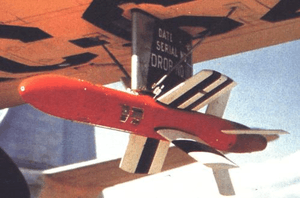AAM-A-1 Firebird
The AAM-A-1 Firebird was an early American air-to-air missile, developed by the Ryan Aeronautical Company. The first air-to-air missile program developed for the United States Air Force, the Firebird was extensively tested in the late 1940s; although it proved successful in testing, it was soon obsolete due to the rapid advances in aircraft and missile technology at the time and did not enter production.
| AAM-A-1 Firebird | |
|---|---|
 | |
| Type | Air-to-air missile |
| Place of origin | United States |
| Service history | |
| In service | 1947-1949 |
| Used by | United States Air Force |
| Production history | |
| Designed | 1946-1947 |
| Manufacturer | Ryan Aeronautical Company |
| Specifications | |
| Mass | 260 pounds (120 kg) |
| Length | 7 feet 6 inches (2.29 m) |
| length | Booster, 1 foot 10 inches (0.56 m) |
| Diameter | 8 inches (200 mm) |
| Warhead | High explosive |
| Warhead weight | 90 pounds (41 kg) |
| Engine | Liquid-fuel rocket, 620 lbf (2.8 kN) Booster, solid-fuel rocket, 2,800 lbf (12 kN) |
| Wingspan | 2 ft 8 in (0.81 m) |
Operational range | 8 miles (13 km) |
| Maximum speed | Mach 0.85 |
Guidance system | Midcourse: Radio command Terminal: Active radar homing |
Launch platform | DB-26 Invader DF-82 Twin Mustang |
Design and development
The AAM-A-1 project began in 1946 with the awarding of a study contract, under the designation MX-799, to the Ryan Aeronautical Company for the development of a subsonic air-to-air missile, which would be used by interceptor aircraft for the destruction of enemy bombers.[1] A contract for the development of the missile, designated AAM-A-1 Firebird, was awarded in 1947.[1]
The AAM-A-1 Firebird was a two-stage weapon, fitted with cruciform wings and tailfins. Control was by differential motion of the wings; the tailfins were fixed.[1] The missile's fuselage was constructed from aluminum alloy, while the nosecone and control fins were molded from plastic.[2] Firebird was fitted with a solid-fuel booster rocket providing initial thrust, before a liquid-fuel sustainer[N 1] rocket ignited for a 15-second powered flight time.[1]
Guidance was provided during midcourse flight by radio command, with an operator in the launching aircraft transmitting corrections to the missile. Terminal guidance used active radar homing, with a small radar set fitted in the nose of the missile,[3][4][N 2] with the missile's warhead being detonated by a proximity fuse, a backup impact fuze also being fitted.[1]
Operational history
Flight testing of the XAAM-A-1 prototype missiles began in October 1947,[1] launched from DB-26 Invader bomber and DF-82 Twin Mustang aircraft,[1] the latter of which could carry up to four missiles.[3][5] The first air-to-air missile to reach the flight-test stage outside of World War II Nazi Germany,[6] the Firebird proved to be reasonably successful in testing, with production being projected for the early 1950s;[7] however its command-guidance system limited it to clear-weather, daytime use only.[1]
Although radar beam riding guidance was planned to solve this,[6] the subsonic speed of the weapon was also considered to be insufficient to avoid obsolescence; accordingly, the AAM-A-1's production program was terminated late in 1949,[1] the Hughes Falcon being selected for development as the Air Force's standard intercept missile instead.[8] The test program was considered to be successful, despite the rejection by the USAF, as a considerable amount of knowledge was gained that benefited later programs.[9]
A Firebird missile is preserved at the Air Force Space & Missile Museum at Cape Canaveral Air Force Station in Florida.[3]
See also
- Ruhrstahl X-4, the similar-appearance wire guided air-to-air missile design of Nazi Germany (1943–45)
References
- Notes
- Some sources state the sustainer was also solid-fueled.[3]
- Some sources state the terminal guidance was semi-active radar homing.[1]
- Citations
- Parsch 2004
- Popular Science, January 1950, p.144.
- Space & Missile Museum 2011
- Popular Science, March 1952, p.155.
- Ross 1951, p.128.
- Gunston 1979, p.222.
- Bowman 1957, p.113.
- Francillon 1990, p.24.
- Cooke 1951, p.147.
- Bibliography
- "Firebird". Cape Canaveral Air Force Station, FL: Air Force Space & Missile Museum. 2011. Retrieved 2011-02-09.
- "Fighter Fires New Missile". Popular Science. New York: Popular Science Publishing Co. 156 (1). Retrieved 2011-02-09.
- "Tiny Radar Steers Missile". Popular Science. New York: Popular Science Publishing Co. 160 (1). March 1952. Retrieved 2011-02-09.
- Bowman, Norman John (1958). The Handbook of Rockets and Guided Missiles. Chicago: Perastadion Press. ASIN B002C3SPN2.
- Cooke, David Coxe; Martin Caidin (1951). Jets, Rockets, and Guided Missiles. New York: McBride. ASIN B000MRHQEE.
- Francillon, René J. (1990). McDonnell Douglas Aircraft since 1920: Volume II. Annapolis, MD: Naval Institute Press. ISBN 1-55750-550-0.
- Gunston, Bill (1979). The Illustrated Encyclopedia of the World's Rockets & Missiles. London: Salamander Books. ISBN 978-0-86101-029-5.
- Parsch, Andreas (2004). "Ryan AAM-A-1 Firebird". Directory of U.S. Military Rockets and Missiles Appendix 1: Early Missiles and Drones. designation-systems.net. Retrieved 2011-02-08.
- Ross, Frank (1951). Guided Missiles: Rockets & Torpedoes. New York: Lothrop, Lee & Shepard. ASIN B001LGSGX0.
External links
| Wikimedia Commons has media related to AAM-A-1 Firebird. |
- "Air-to-Air Missile for U.S. Planes, Popular Mechanics, February 1950